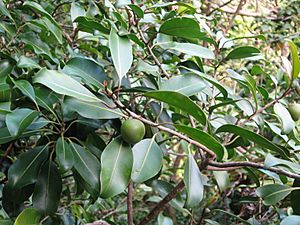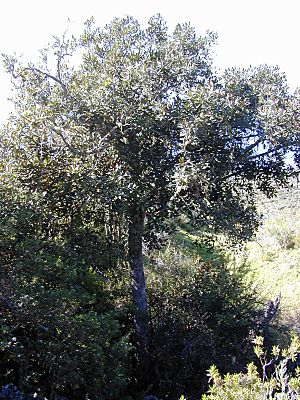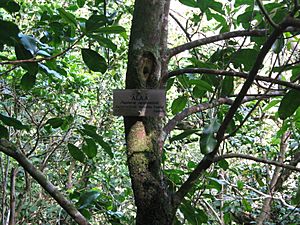Pouteria sandwicensis facts for kids
Quick facts for kids Pouteria sandwicensis |
|
|---|---|
 |
|
| Green fruit and leaves | |
| Scientific classification | |
| Genus: |
Pouteria
|
| Species: |
sandwicensis
|
| Synonyms | |
|
Sideroxylon sandwicense (A.Gray) Benth. & Hook.f. |
|
Pouteria sandwicensis is a type of flowering tree that belongs to the sapodilla family, called Sapotaceae. This tree is endemic, meaning it grows naturally only in the main islands of Hawaii. In the Hawaiian language, this tree has several names, including ʻĀlaʻa, Āulu, and ʻĒlaʻa.
About the ʻĀlaʻa Tree
The ʻĀlaʻa tree grows in different types of forests in Hawaii. You can find it in dry forests, coastal mesic forests (which are somewhat moist), and mixed mesic forests (a mix of dry and wet). It grows at elevations from about 240 to 980 meters (790 to 3,215 feet) above sea level.
This tree can reach a height of about 15 meters (49 feet). Its trunk can grow to be about 0.4 meters (1.3 feet) wide. The bark is thick and grey, with cracks or fissures on the outside. If you look closely, you might see an orange layer inside the bark.
Leaves, Flowers, and Fruit
The leaves of the ʻĀlaʻa tree are arranged alternately along the stem. They are thick and feel like leather. Their shape is usually oblong or elliptical, measuring about 6 to 14 centimeters (2.4 to 5.5 inches) long and 3 to 6 centimeters (1.2 to 2.4 inches) wide. The top side of the leaves is smooth and shiny green. The bottom side is dull and might have bronze or reddish-brown hairs pressed flat against it. Sometimes, these hairs are only found on the very tips of new leaves.
The tree produces small groups of one to four bell-shaped flowers. These flower clusters, called inflorescences, grow at the base of the leaves. After the flowers, the tree produces a berry-like fruit. This fruit is about 3 to 4 centimeters (1.2 to 1.6 inches) across and can be yellow, orange, or even purplish-black when ripe. Each fruit usually contains one to five seeds. These seeds are about 2 centimeters (0.8 inches) long and are yellow-brown in color.
Traditional Uses of ʻĀlaʻa
The wood from the ʻĀlaʻa tree is very special. It is yellow with black stripes, extremely hard, and has a very tight grain. Native Hawaiians used this strong wood for many important things.
They used it to build parts of their houses. They also used it to make the pale, which are the side rails or gunwales of their waʻa (which are outrigger canoes). The wood was also perfect for making ʻōʻō, which were digging sticks used for farming, and ihe, which were spears for hunting or defense.
The tree also produces a sticky, milky sap. This sap was used as a kolū, a type of natural glue. It helped to attach handles to weapons and tools. It was also used as kēpau, which is a sticky substance similar to birdlime. This was used to catch birds, much like the sap from papala kepau (Pisonia trees).
See also
 In Spanish: Pouteria sandwicensis para niños
In Spanish: Pouteria sandwicensis para niños



